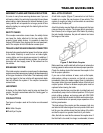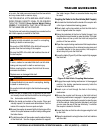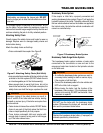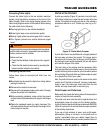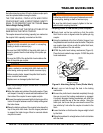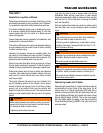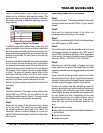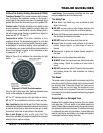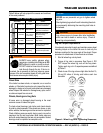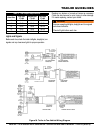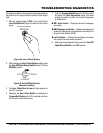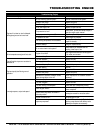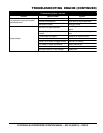
PAGE 62 — DCA70SSJU4i
TRAILER GUIDELINES
Treadwear Number
: This number indicates the tire’s wear
rate. The higher the treadwear number is, the longer it
should take for the tread to wear down. For example, a tire
graded 400 should last twice as long as a tire graded 200.
This letter indicates a tire’s ability to stop
on wet pavement. A higher graded tire should allow you
to stop your car on wet roads in a shorter distance than a
tire with a lower grade. Traction is graded from highest to
lowest as “AA”,”A”, “B”, and “C”.
This letter indicates a tire’s
resistance to heat. The temperature grade is for a tire that
is infl ated properly and not overloaded. Excessive speed,
underinfl ation or excessive loading, either separately or
in combination, can cause heat build-up and possible tire
failure. From highest to lowest, a tire’s resistance to heat
is graded as “A”, “B”, or “C”.
Refer to Figure K for additional tire information for light
trucks.
Figure K. UTQGS Tire Information
Tires for light trucks have other markings besides those
found on the sidewalls of passenger tires.
: The “LT” indicates the tire is for light trucks or trailers.
ST
: An “ST” is an indication the tire is for trailer use only.
kg (lbs) at kPa (psi) Cold: This information
indicates the maximum load and tire pressure when the tire
is used as a dual, that is, when four tires are put on each
rear axle (a total of six or more tires on the vehicle).
kg (lbs) at kPa (psi) Cold: This
information indicates the maximum load and tire pressure
when the tire is used as a single.
: This information identifi es the tire’s load-
carrying capabilities and its infl ation limits.
Tire Safety Tips
Slow down if you have to go over a pothole or other
object in the road.
DO NOT
run over curbs or other foreign objects in the
roadway, and try not to strike the curb when parking.
Check tire infl ation pressure weekly during use to insure
the maximum tire life and tread wear.
DO NOT bleed air from tires when they are hot.
Inspect tires for uneven wear patterns on the tread,
cracks, foreign objects, or other signs of wear or
trauma.
Remove bits of glass and foreign objects wedged in
the tread.
Make sure your tire valves have valve caps.
check tire pressure on tow vehicle and trailer
before towing. Check tire pressure at least once a
month.
DO NOT
overload tow vehicle. Check the tire information
and loading placard for safe allowable tire loading
conditions.
Tire Repair
The proper repair of a punctured tire requires a plug for the
hole and a patch for the area inside the tire that surrounds
the puncture hole. Punctures through the tread can be
repaired if they are not too large, but punctures to the
sidewall should not be repaired. Tires must be removed
from the rim to be properly inspected before being plugged
and patched.
Replacing Worn or Damaged Tires
Replace the tire before towing the trailer if the tire treads
have less than 1/16 inch depth or the telltale bands are
visible. Check infl ation pressure weekly during use to insure
the maximum tire life and tread wear. A bubble, cut or bulge
in a side wall can result in a tire blowout. Inspect both side
walls of each tire for any bubble, cut or bulge; and replace
a damaged tire before towing the trailer.



